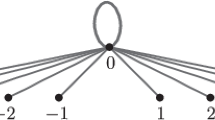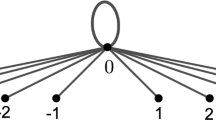Abstract
In this paper we consider a model with nearest-neighbor interactions and with the set [0,1] of spin values, on a Cayley tree of order two. This model depends on two parameters \(n\in \mathbb N\) and \(\theta \in [0,1)\). We prove that if \( 0 \le \theta \le \frac{2n+3}{2(2n+1)}\), then for the model there exists a unique translational-invariant Gibbs measure; If \(\frac{2n+3}{2(2n+1)}< \theta <1\), then there are three translational-invariant Gibbs measures (i.e. phase transition occurs).
Similar content being viewed by others
Avoid common mistakes on your manuscript.
1 Introduction
The notion of a Gibbs measure was first introduced by R.L.Dabrushin as well as Lanford and Ruelle [1, 2], makes use of systems of compatible conditional probabilities with respect to the outside of finite subsets, when the outside is fixed in a boundary condition, to reach thereafter infinite-volume quantities. A central problem in the theory of Gibbs measures is to describe infinite (or limiting) Gibbs measures corresponding to a given Hamiltonian (see [5–8]).
In [3] the Potts model with countable set \(\Phi \) of spin values on \(Z^d\) was considered and it was proved that with respect to Poisson distribution on \(\Phi \) the set of limiting Gibbs measure is not empty. In [4] the Potts model with a nearest neighbor interaction and countable set of spin values on a Cayley tree is studied.
It is well known, the XY model is an example with an uncountable single-spin space \(\Omega =\{x \in R^2: \Vert x\Vert _2=1\}\). In [5–8] several models (Hamiltonians) with-nearest-neighbor interactions and with the set [0, 1] of spin values, on a Cayley tree were considered. In these papers translation-invariant Gibbs measures are studied via a non-linear functional (integral) equation.
In the present note we continue the investigation from [5] and consider a model with nearest-neighbor interactions and local state space given by the uncountable set [0, 1] on a Cayley tree. Note that, in [5] it was proved that the considered model has at least two translational-invariant Gibbs measure. Here we prove that our model has exactly three translation-invariant Gibbs measures on a Cayley tree of order two.
Let us give basic definitions.
The Cayley tree \(\Gamma ^k\) of order \(k \ge 1\) is an infinite tree, i.e., a graph without cycles, such that exactly \(k+1\) edges originate from each vertex. Let \(\Gamma ^k=(V,L)\) where V is the set of vertices and L the set of edges. Two vertices x and y are called nearest neighbors if there exists an edge \(l \in L\) connecting them and we denote \(l=\langle x,y\rangle \). A collection of nearest neighbor pairs \(\langle x,x_1\rangle ,\langle x_1,x_2\rangle , \dots , \langle x_{d-1},y\rangle \) is called a path from x to y. The distance d(x, y) on the Cayley tree is the number of edges of the shortest path from x and y.
For a fixed \(x^0 \in V\), called the root, we set
and denote
the set of direct successors of x.
Consider models where the spin takes values in the set [0, 1], and is assigned to the vertexes of the tree. For \(A \subset V\) a configuration \(\sigma _A\) on A is an arbitrary function \(\sigma _A:A\mapsto [0,1].\) Denote \(\Omega _A=[0,1]^A\) the set of all configurations on A. A configuration \(\sigma \) on V is then defined as a function \(x \in V \mapsto \sigma (x) \in [0,1]\); the set of all configurations is \([0,1]^V\).
The (formal) Hamiltonian of the model is:
where \(J \in R\setminus \{0\}\) and \(\xi : (u,v) \in [0,1]^2 \mapsto \xi _{u,v} \in R\) is a given bounded, measurable function.
Let \(\lambda \) be the Lebesgue measure on [0, 1]. On the set of all configurations on A the a priori measure \(\lambda _A\) is introduced as the |A| fold product of the measure \(\lambda \). Here and further on |A| denotes the cardinality of A. We consider a standard sigma-algebra \(\mathcal {B}\) of subsets of \(\Omega =[0,1]^V\) generated by the measurable cylinder subsets. A probability measure \(\mu \) on \((\Omega , \mathcal {B})\) is called a Gibbs measure (with Hamiltonian H) if it satisfies the DLR equation, namely for any \(n=1,2,...\) and \(\sigma _n \in \Omega _{V_n}\):
where \(\nu _{\omega |_{W_{n+1}}}^{V_n}\) is the conditional Gibbs density
and \(\beta \ge 0\) is a free parameter proportional to the inverse temperature.
2 Non-uniqueness of Gibbs measures
Let
For every \(k\in \mathbb {N}\) we consider an integral operator \(H_{k}\) acting in the cone \(C^{+}[0,1]\) as
The operator \(H_{k}\) is called Hammerstein’s integral operator of order k. This operator is well known to generate ill-posed problems. Clearly, if \(k\ge 2\) then \(H_{k}\) is a nonlinear operator.
It is known that the set of translation invariant Gibbs measures of the model (1.1) is described by the fixed points of the Hammerstein’s operator (see [6]).
In this paper we take \(k=2\) for the model (1.1) and we take concrete \(\xi \) in the following form
where \(0 \le \theta <1\). Then for the Kernel K(t, u) of the Hammerstein’s operator \(H_2\) we have
We defined the operator \(V_2:(x,y) \in R^2 \rightarrow (x', y') \in R^2\) by
Proposition 2.1
A function \(\varphi \in C[0,1]\) is a solution of the Hammerstein’s equation
iff \(\varphi (t)\) has the following form
where \((C_1, C_2) \in R^2\) is a fixed point of the operator \(V_2\) (2.2).
Proof
Necessariness Assume \(\varphi \in C[0,1]\) be a solution of the Eq. (2.3). Then we have
where
Substituting the function \(\varphi (t)\) (2.4) into (2.5) we get
and substituting the function \(\varphi (t)\) into (2.6) we get
Thus, the point \((C_1,C_2) \in R^2\) is a fixed point of the operator \(V_2\) (2.2).
Sufficiency Assume that, a point \((C_1,C_2) \in R^2\) is a fixed point of the operator \(V_2\) define the function \(\varphi (t) \in C[0,1]\) by the equality
Then
Now, we use the following equalities
Then from (2.7) we get
i.e. the function \(\varphi (t)\) is a solution of the Eq. (2.3). \(\square \)
Proposition 2.2
-
i)
If \( 0 \le \theta \le \frac{2n+3}{2(2n+1)}\), then the Hammerstein’s operator \(H_2\) has unique (nontrivial) positive fixed point in the C[0, 1];
-
ii)
If \(\frac{2n+3}{2(2n+1)}< \theta <1\), then there are exactly three positive fixed points in C[0, 1] of the Hammerstein’s operator.
Proof
It is easy to see, if \(\theta =0\) the Hammerstein’s operator \(H_2\) has unique nontrivial positive fixed points \(\varphi (t)\equiv 1\).
Let \(\theta \ne 0\). We consider the system of equations for a fixed point of the operator \(V_2\):
Case \(y=0\). We get two solutions (0,0) and (1,0) in the (2.8). By Proposition 3.2 functions
are solutions of the equation (2.8).
Case \(y \ne 0\). Then from (2.8) we obtain \(x=\frac{2n+3}{2(2n+1) \theta }\). Hence, from the first equation of (2.8) we get
Therefore, for \(\theta \ge \frac{2n+3}{2(2n+1)}\) from (2.9) we obtain
Consequently, in the case \(0 \le \theta \le \frac{2n+3}{2(2n+1)}\) operator \(V_2\) has two fixed points: (0,0), (1,0) and in the case \(\frac{2n+3}{2(2n+1)}< \theta <1\) the operator \(V_2\) has four fixed points: (0,0), (1,0), \((x_1, y_1^{+})\) and \((x_1, y_1^{-})\), with \(x_1=\frac{2n+3}{2(2n+1) \theta }\).
Note that, there is no any other fixed point of \(V_2\). \(\square \)
Consequently,
are non trivial fixed points of the Hammerstein’s operator \(H_2\). Note that \(\varphi _i(t)>0\), for \(i=1, 2, 3\) and \(t \in [0,1]\). Thus we have proved the following
Theorem 2.3
-
i)
If \( 0 \le \theta \le \frac{2n+3}{2(2n+1)}\), then for the model (1.1) on Cayley tree \(\Gamma ^2\) there exists a unique translation-invariant Gibbs measure;
-
ii)
If \(\frac{2n+3}{2(2n+1)}< \theta <1\), then for the model (1.1) on Cayley tree \(\Gamma ^2\) there are three translation-invariant Gibbs measures.
Remark
Note that, in [7] the case \(n=1\) of (2.1), is considered. In the case \(n=1\) from Theorem 2.3 we get Theorem 4.2 of [7].
References
Baxter, R.J.: Exactly Solved Models in Statistical Mechanics. Academic, London (1982)
Rozikov, U.A.: Gibbs measures on Cayley trees: results and open problems. Rev. Math. Phys. 25(1), 1330001 (2013)
Ganikhodjaev, N.N.: Potts model on \(Z^d\) with countable set of spin values. J. Math. Phys. 45, 1121–1127 (2004)
Ganikhodjaev, N.N., Rozikov, U.A.: The Potts model with countable set of spin values on a Cayley tree. Lett. Math. Phys. 74, 99–109 (2006)
Eshkobilov, YuKh, Haydarov, F.H., Rozikov, U.A.: Non-uniqueness of Gibbs measure for models with uncountable set of spin values on a Cayley tree. J. Stat. Phys. 147(4), 779–794 (2012)
Rozikov, U.A., Eshkabilov, YuKh: On models with uncountable set of spin values on a Cayley tree: integral equations. Math. Phys. Anal. Geom. 13, 275–286 (2010)
Eshkabilov, Yu.Kh., Rozikov, U.A., Botirov G.I.: Phase transition for a model with uncountable set of spin values on Cayley tree. Lobachevskii J. Math. 34(3), 256–263 (2013)
Jahnel, Benedikt, Kuelske, Christof, Botirov, Golibjon: Pase rransilition and critical values of a nearest-neighbor system with uncountable local state space on Cayley tree. Math. Phys. Anal. Geom. 17, 323–331 (2014)
Author information
Authors and Affiliations
Corresponding author
Rights and permissions
About this article
Cite this article
Botirov, G.I. A model with uncountable set of spin values on a Cayley tree: phase transitions. Positivity 21, 955–961 (2017). https://doi.org/10.1007/s11117-016-0445-x
Received:
Accepted:
Published:
Issue Date:
DOI: https://doi.org/10.1007/s11117-016-0445-x




